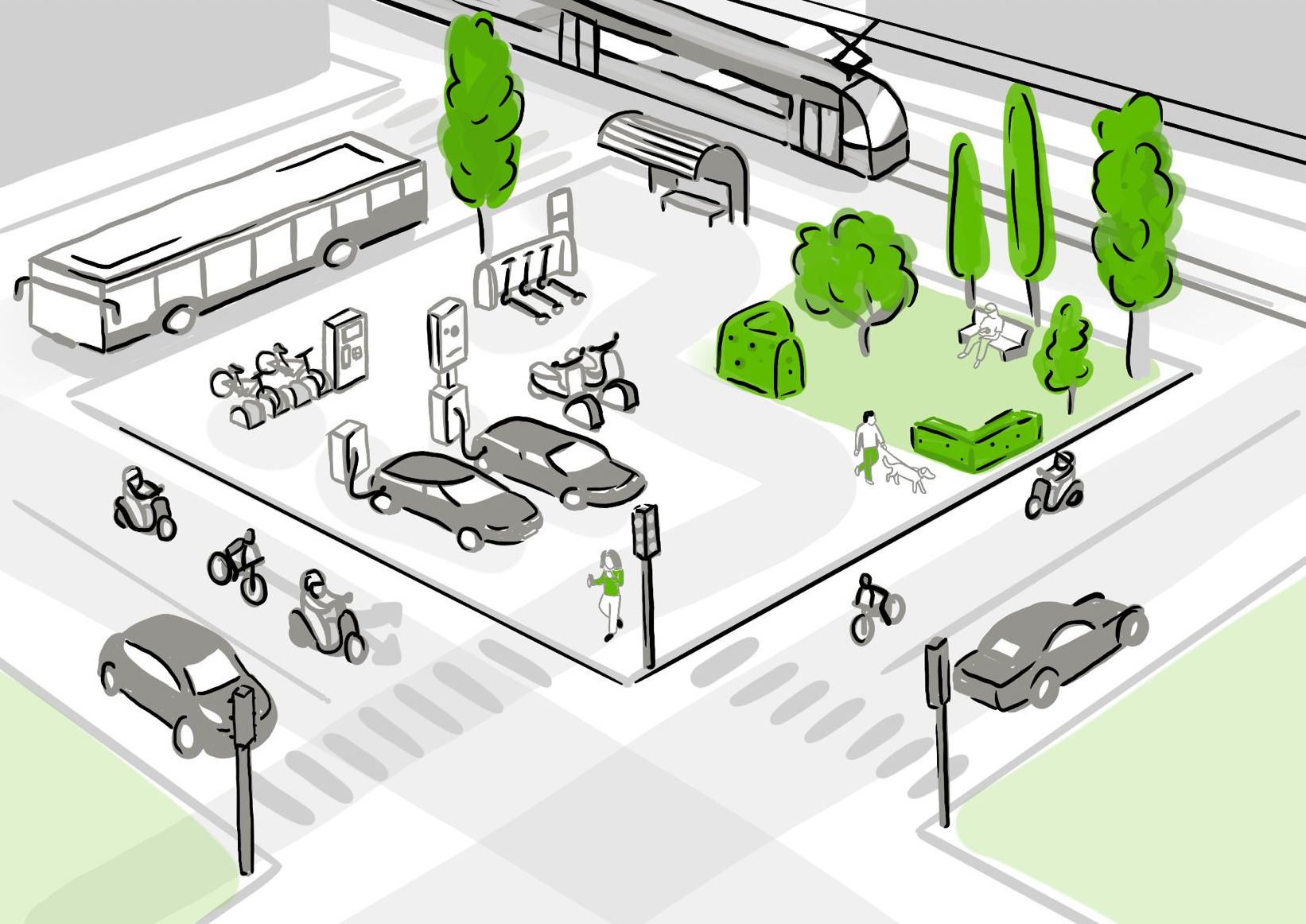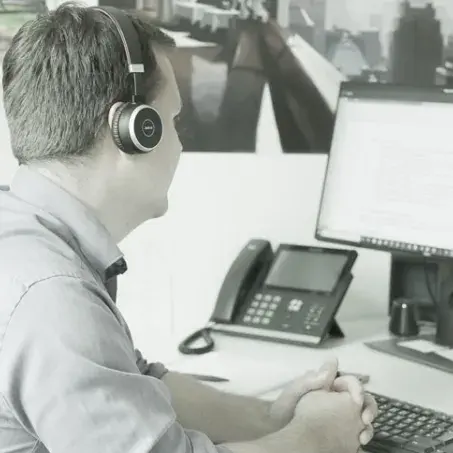We think outside the box when it comes to multimodal and sustainable mobility and actively shape innovation.
Sustainability, multimodality, CCAM - for an agile future.
In all our areas of expertise and for all our software solutions, we have our sights firmly set on current and future challenges.

Multimodality in transportation refers to the use of different
means of transport and transport infrastructures within one journey or
of a transport system.
Multimodality
The choice and usage habits of means of transportation have changed significantly in recent years. Especially in urban areas, for example, owning a car no longer seems to be a goal for younger generations. Vehicles and bikes can be rented flexibly and conveniently for use when needed and alternated with public transportation.
The availability and number of different means of transportation continues to increase; new additions (and some disappearances) in recent years include e-scooters (micromobility), e-mobility and shared mobility. Autonomous means of transportation are on the horizon for the future.
When developing mobility concepts and traffic control systems, we therefore take into account the different local availability of means of transport, their special requirements in terms of prioritization, separate lanes or routing and signaling, as well as different purposes of mobility (public, private, commercial).
We pay particular attention to these aspects:
By using different modes of transport, existing resources such as transport infrastructure and vehicles can be used more efficiently. This helps to reduce land consumption and improve the sustainability of transportation systems.
The integration of environmentally friendly modes of transport such as public transport, cycling and electric mobility into multimodal transport systems can help to reduce the environmental footprint of transport and improve air quality.
Multimodal transportation systems increase accessibility for different population groups, especially for people with limited mobility or without their own vehicle. This contributes to social inclusion and enables more people to participate in social life.
Multimodality promotes the development of shared mobility concepts and MaaS platforms that enable users to seamlessly combine and book different modes of transportation. This can lead to more efficient use of vehicles and a reduction in traffic emissions.
Our team has experts who specialize in individual modes of transport (walking, cycling, public transport such as buses, streetcars or stationary traffic and parking concepts) or who deal with MaaS (mobility as a service). We can test and visualize our proposed solutions for you in microscopic and macroscopic models and simulations.
What combination of transportation routes and means of transport do you want to offer?
We look forward to developing suitable concepts with you.




Sustainability meets the needs of today's generations without endangering future generations.
In the area of mobility and transport, sustainability refers to how means of transport and infrastructure are developed, operated and used in order to minimize environmental impact, use resources efficiently and take social and economic concerns into account in the long term.
Sustainability
We use our experience and expertise in all our consulting, research projects and software solutions to answer the most important questions and most pressing challenges for a sustainable and liveable future in the best possible and individual way for our customers and their situation:

The transport sector is one of the biggest contributors to greenhouse gas emissions and air pollution.
How can we reduce these emissions, noise and particulate pollution and promote more environmentally friendly mobility solutions to improve air quality and combat climate change?
Traffic jams and congested traffic routes not only lead to lost time and frustration for road users, but also to increased emissions and inefficient use of resources and energy consumption.
How can we optimize transport infrastructure and develop sustainable transport concepts to reduce stops, halts and congestion, make optimum use of existing capacities and improve the efficiency of traffic flow?
The increasing demand for mobility and transport services as a result of urbanization is leading to a growing need for resources such as energy, raw materials and land.
How can we promote the choice of environmentally friendly mobility solutions (e- and shared mobility, public transport and non-motorized private transport versus motorized private transport) that reduce the need for resources and minimize land consumption?
How can we optimize the design and distribution of available space?
Not all population groups have equal access to sustainable means of transportation and infrastructure.
How can we develop mobility concepts that are accessible to all population groups and reduce social inequalities in the area of mobility, promote integration, equal opportunities and sustainable development?
The rapid development of technologies such as electric vehicles, autonomous driving and mobility services presents both opportunities and challenges for sustainability in the transport sector.
How can we ensure that these technologies are sustainable and have a positive impact on the environment, society and the economy? How can we increase the use of sustainable technologies and how can the transition succeed even with limited availability of funds or concerns and reservations?
Climate change is one of the biggest challenges for sustainability in the transport sector. Extreme weather events such as floods, storms and heatwaves can damage transport infrastructure and disrupt traffic.
How can we make transport infrastructure more resilient to the effects of climate change and develop adaptation strategies in traffic management?
Overcoming these challenges requires a holistic and coordinated approach based on a combination of policy measures, technological innovations, infrastructure improvements and a change in the behavior of road users. It is crucial that governments, businesses, research institutions and civil society work together to develop and implement sustainable mobility solutions that protect the environment, improve quality of life and are viable in the long term. We actively network stakeholders and participate in committees and associations.



Do you already have future generations in mind?
We support you in making optimum use of your infrastructure and capacities, reducing emissions and noise pollution and developing sustainable mobility concepts.

C-ITS (Cooperative Intelligent Transport Systems) refers to new technologies and systems that network means of transportation with each other and with their environment and make them safer, more efficient and more sustainable as an integrated form of mobility through CCAM (Cooperative, Connected and Automated Mobility).
C-ITS and CCAM
New technologies and innovative approaches are the key to sustainable solutions.
With new data transmission paths and frequencies (such as 5G, G5, fiber optics - cloud services), more data volumes can be exchanged in near real time and enable a variety of new use cases
with more comprehensive content (CAM, DENM, MAP, SPaT, SREM, SSEM, etc.). This enables communication between road users and infrastructure, directly or via central platforms using apps on mobile and fixed devices, e.g. on intelligent display boards on the road or public transport, cell phones, smartwatches, on-board units (OBU), etc.
At Schlothauer & Wauer, we not only develop intelligent algorithms supported by machine learning and AI, but also proactively develop corresponding use cases and solutions for implementation in practice.

At Schlothauer & Wauer, we not only develop intelligent algorithms supported by machine learning and AI, but also proactively develop corresponding use cases and solutions for implementation in practice.
To this end, we participate in numerous research initiatives (e.g. AIAMO, BiDiMove, KoMoDnext, BMVI LOGIN, ViVre , BaSt RiLSA), cooperate with universities and research institutions and participate as members of the relevant organizations in committees and working groups (e.g. FGSV, C-Roads Germany Expert-Group, ODG working group OCIT-C, etc.) in order to answer the pressing questions on dealing with
- shaping the transition to new technologies
- the integration of new approaches into existing infrastructure
- different equipment rates
- Standardization of data content and transmission protocols
- Data protection and security
- General concerns and reservations
to answer your questions. We promote the exchange of experts, also with our own formats such as our CCAM user forum. We already use CCAM data in our software solutions, e.g. in LISA for MAP creation and complex traffic-dependent control systems with the C-ITS function library 2.0.
CCAM data can also be taken into account in ImFlow and MyCityAdaptive/INES and bring a significant improvement in forecasting accuracy for optimal control.
Our SPaTmaker evaluates current data from the infrastructure and delivers SPAT messages from our vehicle buffer for a variety of use cases, such as switching time forecasts for GLOSA services.



Can't imagine a connected future yet?
We show you specific use cases - for today, tomorrow and the day after tomorrow - and support you in integrating CCAM into your traffic management system today.


